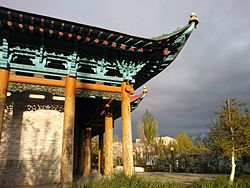Hui people
The Hui people (Chinese: 回族; pinyin: Huízú; Wade–Giles: Hui2-tsu2, Xiao'erjing: خوذو, Dungan: Хуэйзў, Xuejzw) are an East Asian ethnoreligious group. They are mostly Chinese-speaking muslims who live in China. They live mostly in the northwestern provinces of the country and in the Zhongyuan region. As of the 2011 census, China is home to about 10.5 million Hui people. Most of Hui people are Chinese-speaking Muslims. The 110,000 Dungan people of Kazakhstan and Kyrgyzstan are also part of the Hui ethnicity.
回族 خوذو | |
|---|---|
| Total population | |
| 10,586,087 (2011 Census) | |
| Regions with significant populations | |
| China, Kazakhstan, Kyrgyzstan, Uzbekistan, Russia, Saudi Arabia, Malaysia, Singapore, Indonesia, Myanmar, Thailand | |
| Languages | |
| Mandarin Chinese, Dungan and other Sinitic languages | |
| Religion | |
| Predominantly Sunni Islam[1][2][3] | |
| Related ethnic groups | |
| Hui people | |||||||||||||||||||||||||||||||||
|---|---|---|---|---|---|---|---|---|---|---|---|---|---|---|---|---|---|---|---|---|---|---|---|---|---|---|---|---|---|---|---|---|---|
| Chinese | 回族 | ||||||||||||||||||||||||||||||||
| |||||||||||||||||||||||||||||||||
They have a connection with Islamic culture.[4] For example, as Muslims, they follow Islamic dietary laws and do not eat pork. Pork is the most commonly eaten meat in China.[5] They hve created their own version of Chinese cuisine. Hui clothing is different from that of the Han Chinese. Some men wear white caps (taqiyah) and some women wear headscarves, This is the case in many Islamic cultures.
The Hui people are one of 56 ethnic groups recognized by China. The government says the Hui people include all Muslim communities that are not included in China's other ethnic groups. They are seperate from other Muslim groups such as the Uyghurs.[6] The Hui mostly speak Chinese.[4] There are some Arabic and Persian phrases in their speach.[7] The Hui ethnic group is not associated with a non-Sinitic language.[8]
The Hui people are more concentrated in Ningxia, Gansu, Qinghai and Xinjiang) in Northwestern China. Communities exist across the country.
Many Hui are clerics, interpreters, jewelers, tea traders, tanners, butchers, caravaneers, cavalrymen, shepherd, innkeeper, restauranteers[9][10] and jade carvers.[11]
Hui People Media
Halal (清真) restaurants offering Northwestern beef lamian can be found throughout the country
A halal (清真) shower house in Linxia City
The minaret of the Dungan mosque in Karakol, Kyrgyzstan
Dungan mosque in Karakol, Kyrgyzstan
Muslim restaurant in Kunming, Yunnan
Hui people praying in the Dongguan Mosque, Xining
The Sufi mausoleum (gongbei) of Ma Laichi in Linxia City, China.
References
- ↑ By choosing assimilation, China's Hui have become one of the world's most successful Muslim minorities. 8 October 2016. https://www.economist.com/news/china/21708274-choosing-assimilation-chinas-hui-have-become-one-worlds-most-successful-muslim. Retrieved 8 October 2016.
- ↑ "الماتريدية وآثارها في الفكر الإنساني بدول طريق الحرير.. الصين نموذجا". Alfaisal Magazine.
- ↑ "الحنفية الماتريدية في بلاد الصين". midad.com.
- ↑ 4.0 4.1 Gladney 1996, p. 20.
- ↑ Gladney 1996, p. 13 Quote: "In China, pork has been the most basic source of animal protein for centuries and Chairman Mao considered it 'a national treasure'"
- ↑ Lipman 1997, p. xxiii or Gladney 1996, pp. 18–20 Besides the Hui people, nine other ethnic groups of PRC are considered mostly Muslim. Those nine groups are defined by language. Six groups speak Turkic languages, they are the Kazakhs, Kyrgyz, Salars, Tatars, Uyghurs and Uzbeks). There are two Mongolic-speaking groups (Bonan and Dongxiang) and one Iranian-speaking group (Tajiks).
- ↑ Dillon 2013, pp. [Hui people at Google Books 154–].
- ↑ Lipman 1997, p. 50 The ancestors of today's Hui people are thought to have been native Chinese speakers of Islamic religion since no later than the mid or early Ming Dynasty. [i.e. the late 14th to late 16th centuries]
- ↑ Gladney 1996, p. 30 Quote:... to their Islamic restrictions in diet and hygiene , leading them to take up such occupations as restauranteur , innkeeper , shepherd , cavalryman , caravaneer , butcher , tanner , tea trader , jeweler , interpreter , and clergyman .
- ↑ International Association for the Study of Traditional Environments (1998). Traditional Dwellings and Settlements Review: Journal of the International Association for the Study of Traditional Environments, Volume 9, Issue 2. The Association. p. 14.
... to assume occupations many Chinese would have considered distasteful , such as butcher , tanner and money - lender , as well as such other more common occupations as jeweler , innkeeper , tea trader , interpreter and caravaneer .
- ↑ Gladney 1996, p. 195 Quote: Knowing - jade Hui ” ( shiyu Huihui ) have ...
- ↑ Jingyuan (2014). "Too Far from Mecca, Too Close to Peking: The Ethnic Violence and the Making of Chinese Muslim Identity, 1821-1871". History Honors Projects. 27: 37.
- ↑ 罗, 尔纲 (1980). "杜文秀"卖国"说辟谬". Biology.
Sources
- Gladney, Dru C. (1996). [Hui people at Google Books Muslim Chinese: Ethnic Nationalism in the People's Republic] (2nd ed.). Harvard University Asia Center. ISBN 0-674-59497-5.
{{cite book}}: Check|url=value (help) (1st edition appeared in 1991) - Dillon, Michael (16 December 2013). [Hui people at Google Books China's Muslim Hui Community: Migration, Settlement and Sects]. Taylor & Francis. ISBN 978-1-136-80940-8. Retrieved 27 June 2015.
{{cite book}}: Check|url=value (help) - Lipman, Jonathan Neaman (1997). Familiar Strangers: A History of Muslims in Northwest China. University of Washington Press. ISBN 978-029-597-644-0. Retrieved 17 August 2018.









